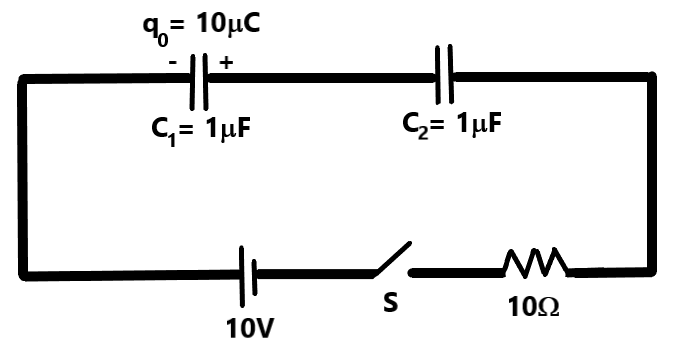Question
Question: In the circuit shown, the capacitor \({{C}_{1}}\) has an initial charge \({{q}_{0}}=10\mu C\). When ...
In the circuit shown, the capacitor C1 has an initial charge q0=10μC. When the switch S is closed, and steady state is reached,

1)work done by cell is 100μJ
2)amount of energy dissipated through resistor is 100μJ
3)Charge on C1 is 10μC
4)Charge on C2 is 0μC
Select the correct statement
A)1,2B)1,3C)2,4
D)None of these
Solution
The given capacitors in the circuit are connected in series. Equivalent capacitance of capacitors connected in series is deduced. With this equivalent capacitance, work done by the cell as well as the energy dissipated through the resistor is determined. In an RC circuit, work done by the cell, energy dissipated through the resistor and the energy stored in the capacitor are equal.
Formula used:
1)C1=C11+C21+C31+...+Cn1
2)E=21QV
3)E=W=Er
Complete answer:
In the circuit given below, it is clear that capacitor C1 and capacitor C2 are connected in series.

We know that equivalent capacitance of n capacitors connected in series is given by
C1=C11+C21+C31+...+Cn1
where
n is any positive integer
Cis the equivalent capacitance of n capacitors connected in series
C1,C2,C3,...,Cn are the capacitances of n capacitors
Let this be equation 1.
In the given circuit, when the switch S is turned ON and steady state is reached, using equation 1, equivalent capacitance of C1 and C2 is given by
C1=C11+C21=1μF1+1μF1=2μF⇒C=0.5μF
where
C is the equivalent capacitance of C1 and C2 connected in series
C1=C2=1μF, as provided in the question
Let this be equation 2.
Now, we know that charge stored in a capacitor is given by
Q=CV
where
Q is the charge stored in a capacitor when voltage V is applied on the capacitor with capacitance C
Let this be equation 3.
Using equation 3, charge stored in the equivalent capacitor of capacitance C in the given circuit is expressed as
Q=CV=0.5μF×10V=5μC
where
Q is the charge stored in the equivalent capacitor
V=10V is the applied voltage on the equivalent capacitor
C is the capacitance of the equivalent capacitor
Let this be equation 4.
Here, it needs to be understood that both capacitors in the given circuit store the same charge, which we determined with the help of equivalent capacitance. Therefore,
Q1=Q2=Q=5μC
where
Q1 is the charge stored in capacitor C1
Q2 is the charge stored in capacitor C2
Q=5μC, from equation 4
Let this be equation 5.
Now, let us move on to calculate the energy stored in both the capacitors C1 and C2.
We know that energy stored in a capacitor is given by
E=21QV
where
E is the energy stored in a capacitor
Q is the charge stored in the capacitor
V is the voltage applied to the capacitor
Let this be equation 6.
If E1 and E2 represent the energies stored in capacitors C1 and C2 respectively, using equation 6, the total energy stored in both capacitors E is given by
E=E1+E2=21Q1V+21Q2V=21V(2Q)=QV=5μC×10V=50μJ
where
V=10V, as provided in the question
Q1=Q2=Q=5μC, from equation 5
Therefore, the total energy stored in capacitors C1 and C2 is equal to 50μJ
Now, we know that work done by cell is equal to the energy stored in capacitors C1 and C2.
Clearly,
W=E=50μJ
where
W is the work done by the cell in the given circuit
E is the total energy stored in capacitors C1 and C2
Let this be equation 7.
We also know that energy dissipated through a resistor in the given circuit is equal to the energy stored in the capacitors C1 and C2. Clearly,
ER=E=50μJ
where
ER is the energy dissipated by the resistor in the given circuit
E is the total energy stored in capacitors C1 and C2
Let this be equation 8.
So, the correct answer is “Option D”.
Note:
Students need to be thorough with the formula for equivalent capacitance of capacitors, connected in series. The formula for the same looks very similar to the formula for equivalent resistance of resistors connected in parallel. Any confusion arising here needs to be easily ruled out. Students need to be thorough with the formula for energy stored in the capacitor too. Energy stored in capacitor can also be expressed as
E=21QV=21CV2
The second expression in the above equation can also be used to arrive at the required results for the given question.
